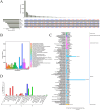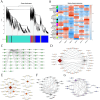Integrative analysis of the metabolome and transcriptome provides insights into the mechanisms of flavonoid biosynthesis in Polygonatum
- PMID: 39888911
- PMCID: PMC12140110
- DOI: 10.1371/journal.pone.0318026
Integrative analysis of the metabolome and transcriptome provides insights into the mechanisms of flavonoid biosynthesis in Polygonatum
Abstract
A noteworthy group of culinary and medicinal plants is Polygonatum species. They are known for their abundant flavonoid compound-rich rhizomes, which have antioxidative and anticancer activities. Using Polygonatum sibiricum Red (SXHZ) and Polygonatum kingianum var. grandifolium (HBES), we conducted transcriptome and metabolomic investigations to look into the molecular processes that control the manufacture of these flavonoids in Polygonatum plants. Seven distinct flavonoid metabolites were identified by the analytical data, with phloretin exhibiting a notable differential expression in the biosynthetic pathway. 30 genes with differential expression were found in both plants after further investigation, five of which are members of the transcription factor family associated with MBW. Thus, we suggest that Phloretin and the genes belonging to the MYB-related transcription factor family play a crucial role in controlling the flavonoid biosynthesis pathway in Polygonatum. This work lays the groundwork for a deeper comprehension of the biosynthesis and metabolic processes of flavonoids in Polygonatum, serving as an invaluable resource for the development of the polygonatum-related pharmaceutical industries as well as for the future breeding of Polygonatum plants with higher flavonoid content.
Copyright: © 2025 Wan, Xiao. This is an open access article distributed under the terms of the Creative Commons Attribution License, which permits unrestricted use, distribution, and reproduction in any medium, provided the original author and source are credited.
Conflict of interest statement
The authors have declared that no competing interests exist.
Figures







Similar articles
-
Integrative analysis of the metabolome and transcriptome provides insights into the mechanisms of amino acids and their derivatives biosynthesis in Polygonatum.PLoS One. 2025 Jun 25;20(6):e0327145. doi: 10.1371/journal.pone.0327145. eCollection 2025. PLoS One. 2025. PMID: 40561134 Free PMC article.
-
Multiomics Reveals the Effect of Root Rot on Polygonati Rhizome and Identifies Pathogens and Biocontrol Strain.Microbiol Spectr. 2022 Apr 27;10(2):e0238521. doi: 10.1128/spectrum.02385-21. Epub 2022 Feb 28. Microbiol Spectr. 2022. PMID: 35225655 Free PMC article.
-
Single-cell transcriptomics and time-series metabolite profiling reveal the spatiotemporal regulation of flavonoid biosynthesis genes and phytohormone homeostasis by PAP1 in Arabidopsis.BMC Biol. 2025 Jul 1;23(1):191. doi: 10.1186/s12915-025-02297-6. BMC Biol. 2025. PMID: 40598113 Free PMC article.
-
Signs and symptoms to determine if a patient presenting in primary care or hospital outpatient settings has COVID-19.Cochrane Database Syst Rev. 2022 May 20;5(5):CD013665. doi: 10.1002/14651858.CD013665.pub3. Cochrane Database Syst Rev. 2022. PMID: 35593186 Free PMC article.
-
Systemic pharmacological treatments for chronic plaque psoriasis: a network meta-analysis.Cochrane Database Syst Rev. 2021 Apr 19;4(4):CD011535. doi: 10.1002/14651858.CD011535.pub4. Cochrane Database Syst Rev. 2021. Update in: Cochrane Database Syst Rev. 2022 May 23;5:CD011535. doi: 10.1002/14651858.CD011535.pub5. PMID: 33871055 Free PMC article. Updated.
References
-
- Liu D, Chen Q, Miao Y, Li J, Deng X. First Report of Southern Blight on Polygonatum sibiricum Caused by Sclerotium delphinii in China. Plant Dis. 2021; 1052268–2740. 10.1094/pdis-10-20-2151-pdn - DOI
MeSH terms
Substances
LinkOut - more resources
Full Text Sources

